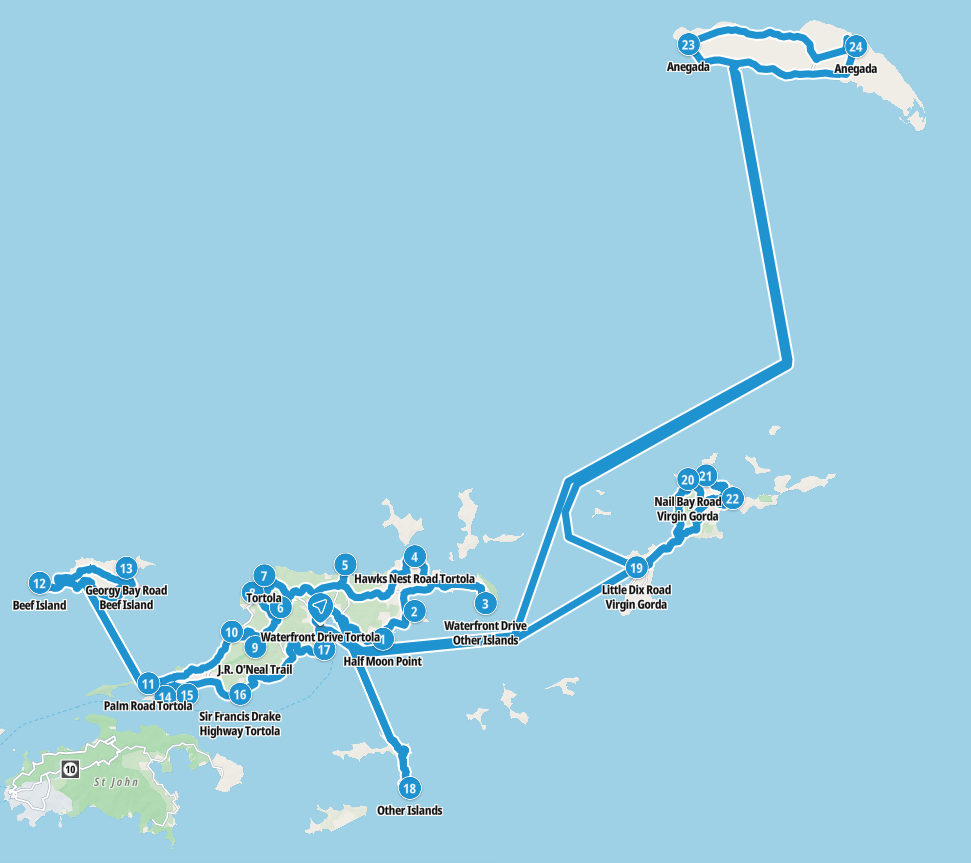British Virgin Islands – Let’s explore here
What’s it like in the British Virgin Islands?
The British Virgin Islands (BVI) are a set of around 50 volcanic islands located in the Caribbean Sea in North America. As a British Overseas Territory, the British monarch is the head of state. The territory has a population of around 30,000 people (2019), about two in five of whom live in the capital city, Road Town, on the island of Tortola.
The largest island is Tortola, which is around 12 miles (20 km) long and 3 miles (5 km) wide. The total area of all of the islands is about the same as that of Liechtenstein. The terrain on the islands consists mostly of hills and forests, with some lovely beaches. The British Virgin Islands’ highest peak is Mount Sage, at 1,716 ft (523 m) above sea level.
Although the BVI rely heavily on tourism like many other Caribbean islands, they are also a tax haven.

A bit about the history of the British Virgin Islands
Early History and Indigenous Peoples
The BVI were originally inhabited by the Arawak and Carib peoples before the arrival of Europeans. These indigenous peoples lived on the islands for centuries, leaving behind evidence of their settlements, although their cultures were largely displaced after European colonisation.
European Discovery and Colonisation
The first European to discover the BVI was Christopher Columbus in 1493. Columbus named the islands after St. Ursula and her 11,000 virgins. However, it was not until the 17th century that the British began to establish a permanent presence on the islands. The BVI were initially used as a base for privateers, with the British eventually claiming them as part of their Caribbean empire.
Plantation Economy and Slavery
During the 17th and 18th centuries, the British Virgin Islands, like many Caribbean colonies, relied on agriculture for its economy. Sugar plantations were established, and enslaved Africans were brought to work on the plantations. Slavery played a key role in the development of the islands’ economy, and the population of enslaved Africans grew rapidly during this period. Slavery was abolished in the British Caribbean in 1834, which led to significant social and economic changes.
Governance and British Colonial Rule
The BVI were part of the larger British Caribbean colonies. The islands were governed from Tortola, the largest island in the group, and later became a part of the British Leeward Islands colony. The BVI was governed by a series of British-appointed officials, though the islanders had limited local representation. Over time, the BVI were granted more self governance, with the establishment of local institutions and legislative bodies.
Economic Transition and 20th Century Development
In the 20th century, the British Virgin Islands shifted away from agriculture and toward tourism and offshore finance. With its warm climate, scenic landscapes and proximity to the United States, the islands became an increasingly popular tourist destination. At the same time, the BVIs economy grew through the development of a financial services sector, with many international businesses setting up operations in the territory due to favorable tax policies.
Self-Governance and Modern Era
In 1967, the British Virgin Islands was granted internal self government, with a locally elected legislature and executive council. Though the territory remains a British Overseas Territory, it exercises significant autonomy in most domestic affairs, including education, health and the economy. The relationship with the United Kingdom remains strong, and the British Virgin Islands continues to be a part of the British Caribbean.
Contemporary British Virgin Islands
Today, the British Virgin Islands is a prosperous territory with a high standard of living. The economy is dominated by tourism, finance and services. The islands remain an important offshore financial center, attracting international businesses and investors. While discussions on independence have occasionally surfaced, the majority of the population prefers to maintain its status as a British Overseas Territory. The islands continue to be a popular destination for visitors and a key player in the Caribbean economy.

British Virgin Islands road trip
The British Virgin Islands is our 20th planned stop on our road trip through the islands of the Caribbean. Having explored Montserrat, our next stop is the US Virgin Islands.
Travelling overland between the islands is quite prohibitive due to the lack of transportation options. Travelling between different island countries via ferry is possible, however, ferries only operate between some islands. Chartering private boats between islands is also possible, although travelling with a car in this way is prohibitive. Flying is another option, although again, flights only operate between some islands.
Map of our road trip through the British Virgin Islands

This is a map of our planned route around the British Virgin Islands, starting and ending at the capital, Road Town.
Weather in the British Virgin Islands
When is the best time to visit the British Virgin Islands?
The best time to visit the BVI is from December to April. During these months, the islands have 8-9 hours of sunshine per day and rainfall of 2.0 – 3.1 inches (50 – 80mm) per month. The temperature ranges from 24 – 30°C (75 – 85°F).
When is the worst time to visit the British Virgin Islands?
The worst time to visit the BVI is from July to November. During these months, the islands still have 8-9 hours of sunshine per day. However, humidity rises and it rains an average of 3.3 – 5.7 inches (85 – 145mm) per month. The temperature ranges from 26 – 32°C (78 – 89°F).
Hurricane Season in the Caribbean
Hurricane season in the Caribbean runs from June 1 to November 30. Storms tend to be more frequent and more severe in the latter half of the season.
Hurricanes are least likely during December, January and February.
Travel in and around the British Virgin Islands
Ferries to other islands within the BVI
New Horizon ferry Service, Smiths ferry Services and Speedy’s Ferry Services travel between the British Virgin Islands.
Ferries to other Caribbean island countries from the BVI
Aquatic Rentals Ferry Services, New Horizon ferry Service, Road Town Fast Ferry, Smiths ferry Services and Speedy’s Ferry Services all travel between the British Virgin Islands and the US Virgin Islands.
What’s it like to drive in the British Virgin Islands?
They drive on the left hand side of the road in the BVI. The majority of the roads in the British Virgin Islands are in fairly good condition, although some more minor roads are little more than dirt tracks.
Do you require an international driving permit in the BVI?
We’ve created a dedicated page to driving abroad, which answers this question, and more, which you might find helpful.
Can you use your UK driving license when driving through the BVI?
We’ve created a dedicated page to driving abroad, which answers this question, and more, which you might find helpful.
Do I need a carnet de passages to drive in the BVI?
We’ve created a dedicated page to driving abroad, which answers this question, and more, which you might find helpful.
What are the speed limits in the BVI?
The speed limits for cars in the BVI are:
- 20 mph (30 km/h) for urban driving
- 35 mph (50 km/h) outside of built up areas
What currency do they use in the BVI?
In the British Virgin Islands they use the US dollar. Cash is widely used. The use of credit / debit cards is widely accepted in tourist areas. Travellers cheques are not generally accepted. There are many ATMs in tourist areas, although not all accept foreign issued cards.
You should make yourself aware of the amount that your bank charges you for using credit and debit cards abroad. Often credit cards are cheaper for purchasing items directly, and for withdrawing cash from ATMs.
What language do they speak in the British Virgin Islands?
They speak English and Creole in the BVI. Spanish is also spoken by some.
What time zone is the BVI in?
Remember, when you’re planning your next trip to take a look at what time zone it’s in.
Do I need a visa to visit the British Virgin Islands?
We’ve created a dedicated, more comprehensive page on visas, which you should find helpful. Check it out!
Is wild camping legal in the British Virgin Islands?
No, wild camping is illegal in the BVI.
What plug / socket type do they use in the British Virgin Islands?
In the BVI they use plug / socket types A and B.


Health issues in the British Virgin Islands
Is it safe to drink water in the British Virgin Islands?
Yes, it is safe to drink tap water in the BVI. Bottled water is also readily available across the territory.
What vaccinations are required for the British Virgin Islands?
This NHS website is kept up to date with all relevant information on vaccinations in the British Virgin Islands.
Phones in the British Virgin Islands
What is the country calling code for the BVI?
The country calling code for the British Virgin Islands is +1 284
What are the emergency phone numbers in the British Virgin Islands?
- The emergency number for police in the BVI is: 911 / 999 / 311
- In the BVI, the emergency number for ambulance is: 911 / 999
- The emergency number for fire in the BVI is: 911 / 999
If you’ve got some useful info that you’d like to share, let us know!
And don’t forget to check out all the other pictures!
